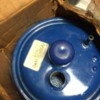This might be a really stupid question but do the fuel vapor cannisters go bad? I know that if the charcoal gets fuel soaked like if you over fill the tank then it can lose its ability to absorb vapor.
My fuel vapor cannister wasn't connected to the separator fuel vapor vent on the fuel tank and has probably been that way for the last 44 years. I was wondering if there was anything I needed to do before hooking up again.
Original Post






